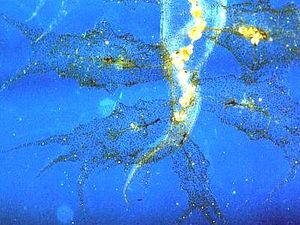Zooxanthellae
Zooxanthellae
Physiology
- Physical characteristics
- Zooxanthellae are part of the group dinophyta, which are single-celled mixotrophic microorganisms.
This class of organisms has two flagella, one transverse and one longitudinal. The longitudinal flagella is used as a rutter for directional steering.
The transverse flagella is used for propultion. It is two to three times the length of the longitudinal flagellum and is composed of axoneme, which causes the
organelle to take on a striated form (like a ribbon). The flagella possess mastigonemes (small flagellar hairs).
Dinoflagellates use thecal plates as a method of defense against predators. Theca are armor-like plates on the exterior of the cell that are composed
of cellulose. Note: individuals may not have thecal plates at all stages of their life cycle.
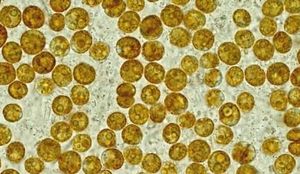
- Genetic characteristic
- part of a group of dinoflagellates
- Flagellated
- Thecal Plates
- part of a group of dinoflagellates
- Zooxanthellae is the name given to a wide array of different algae of the genus Symbiodinium
- Behavior
- live in the tissues of other organisms
- Cnidarians (Coral Polyps, Jellyfish)
- live in the tissues of other organisms
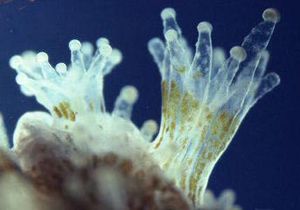
- Nudibranchs (Sea Slugs)
- Under-represented in the water column
Mutualistic Relationship with Coral Reefs
- Photosynthesis
- Corals provide a safe environment and compounds needed for photosynthesis
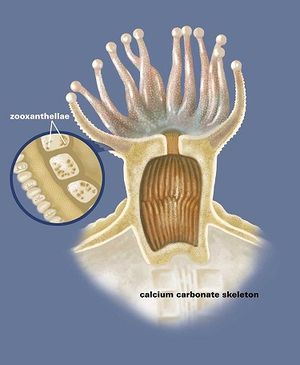
- Zooxanthellae provide food (nutrients) for the coral to use in order to secrete calcium carbonate skeleton
- Highly efficient exchange of nutrients
- Relationship has lasted for more than 200 million years
- Sugar/Carbohydrate Export
- Amino Acid Export
Environmental Impact & Coral Bleaching
- Bleaching occurs when environmental stress adversely affects the mutually beneficial relationship between the host organism and its zooxanthellae.
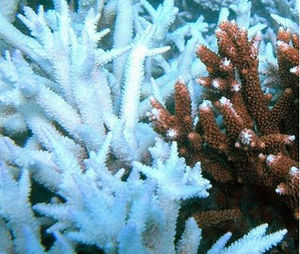
Sources
http://oceanservice.noaa.gov/education/kits/corals/coral02_zooxanthellae.html (accessed on 2/23/13)
http://coralreef.noaa.gov/aboutcorals/coral101/symbioticalgae/ (accessed on 2/23/13)
http://www.biolbull.org/content/137/3/506.short
http://www.int-res.com/articles/meps/71/m071p065.pdf
http://www.int-res.com/articles/meps/180/m180p139.pdf
http://link.springer.com/article/10.1007%2FBF00348077?LI=true
Picture Sources
1. http://www.seaslugforum.net/
